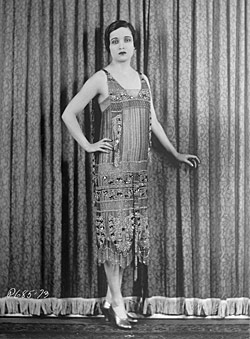
Unit 5: Crisis and Change
Lesson D: Postwar Anxiety, Creativity, and Change
Activity 6: Women's Lives Change after World War I - Equal Rights
World War I disrupted the patterns of daily life for women. During World War I, women in the United States and Europe had taken jobs to help the war effort. Women took jobs traditionally reserved for men — driving trucks, building weapons, and laboring on farms.
Directions: Study the images to learn about women's roles during and after World War I. Note there is no audio with this presentation.
After the war, women in Europe and the United States embraced social freedoms, abandoning the physical and symbolic constraints of corsets and long dresses. They cut their hair into a "bobbed" style and wore short skirts. The era of the "flapper" gave rise to a new spirit of emancipation for women.

Actress and Flapper Alice Joyce, 1926 [1]
Classroom Activity - Women's Lives in the 1920s
![]() Discussion
Discussion
Directions: Prepare a response to the discussion questions below. Follow your teacher's directions to participate in your class discussion.
- Explain the impact of World War I on the roles of women.
- Describe the roles of women in the 1920s.
- How did the roles of women change in the 1920s?
![]() Select the link to review the Discussion Scoring Tool (pdf).
Select the link to review the Discussion Scoring Tool (pdf).
After the war, women in many countries gained suffrage, or the right to vote. In the next activity, review the timeline of important international dates for women's rights, particularly the right to vote.
Page Notes:
[1] Source: This image from http://en.wikipedia.org/wiki/File:Alicejoyce1926full.jpg is under the fair use act and is in the public domain.


